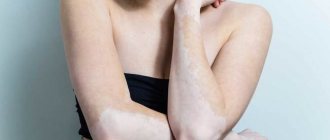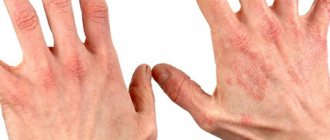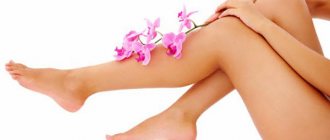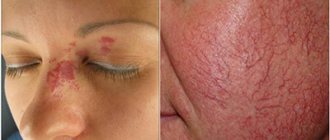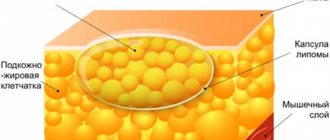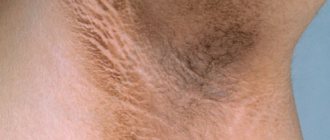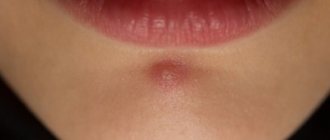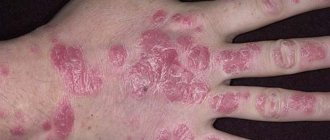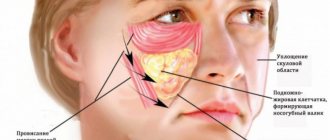Neurodermatitis and diathesis are stages of atopic dermatitis, a chronic skin disease of neuro-allergic origin. In pediatrics, the term “diathesis” is used to indicate in a newborn’s medical record that his body is predisposed to allergies. In older age, atopic dermatitis is simply called neurodermatitis. Neurodermatitis manifests itself in children as an itchy rash on the skin. Symptoms of the disease can be eliminated through drug treatment and changes in the diet of the baby or nursing mother.
Causes
Neurodermatitis in children is a pathological reaction of the skin to a variety of provoking factors. The disease develops due to disturbances in the functioning of the immune system and is often combined with other similar pathologies: atopic dermatitis, severe allergies and bronchial asthma.
The causes of neurodermatitis in children are varied. According to some scientists, the disease begins to form during intrauterine development, when all organs, including the immune system, are formed. Moreover, the causes of neurodermatitis in children may be associated with any impact on the fetus during pregnancy. They contribute to the formation of prerequisites for the development of the disease.
In the general understanding, the cause of neurodermatitis in children is still unformed immunity, in which the child’s body is not able to withstand adverse environmental factors. Heredity plays an important role here. If close relatives have had dermatological diseases, then the child is likely to develop it.
Other probable causes of neurodermatitis:
- poor nutrition;
- previous infections;
- helminthic infestations
- intoxication of the body;
- exposure to allergens;
- severe stress;
- pathologies of internal organs, in particular the kidneys and liver.
Allergenic factors include:
- household mites;
- animal fluff and hair;
- some food products;
- chemical aerosols;
- medications;
- synthetic materials;
- plant pollen.
The psychosomatics of neurodermatitis in a child plays a special role. In this case, rashes occur against the background of disturbances in the functioning of the nervous system. Because of this, he becomes withdrawn and nervous. Many children with this diagnosis have difficulty communicating with others.
Psychosomatics of neurodermatitis in a child may be due to lack of attention from the mother. Also, since the skin is the border separating a person from the world, skin diseases can occur when contact with it is disrupted. This is a kind of way to escape from the outside world, to distance yourself from it. Children with increased susceptibility to criticism, who are guided by the opinions of others and who are ashamed of their appearance are prone to neurodermatitis.
Possible complications
If neurodermatitis in an infant is severe, then due to weakened immunity, a secondary infection may join this disease:
- Staphylococcal or bacterial - blisters of different sizes appear on the skin of children with a clear serous fluid, which becomes cloudy after a while. Purulent blisters burst, and in their place superficial erosions and crusts appear. The child may have a fever. In the absence of adequate treatment, chronic recurrent furunculosis may form against the background of neurodermatitis.
- Herpes simplex virus - infectious agents either already live in the body and are activated due to weakened immunity, or the child becomes infected with them from loved ones. Neurodermatitis complicated by the herpes simplex virus is manifested by an increase in temperature up to 40°C, intoxication of the body, nausea, and muscle cramps.
To avoid complications, children must be taken to see a pediatrician in a timely manner and follow all recommendations given to them.
Proper nutrition and hygiene are important for treating the disease.
Self-diagnosis and self-medication can lead to disability.
Clinical options
Neurodermatitis in children can occur in several clinical forms. They differ in the localization of the rashes, as well as the treatment regimen. Another difference lies in the severity of the signs, which depends on several conditions, including the age and characteristics of the child’s physical development.
There are the following clinical variants of the course of neurodermatitis:
- local. Also called limited, which indicates the nature of the rash. They appear in one area of the body, or less often in two adjacent areas. Moreover, the rash can be observed almost everywhere: on the face, back, arms or legs, etc.;
- linear. With this form of neurodermatitis, the rashes are localized mainly on the arms or legs;
- diffuse. Unlike local, this variant of the flow is accompanied by the appearance of spots on different parts of the body at the same time;
- hypertrophic. It has another name - Ehrmann's neurodermatitis. The form of the pathology is quite rare, accompanied by foci of inflammation in the area of the inguinal-femoral folds and the inner surface of the thighs;
- psoriasiform. The rashes are represented by compacted areas of skin with elements of peeling. They appear on the face, scalp and neck;
- follicular. Rashes occur in the scalp area. Papules are characterized by a pointed shape. They are localized along the mouths of the hair follicles.
Modern treatment of chronic neurodermatitis in children using drugs
Therapy for this form of dermatitis must be comprehensive. The list of medications is determined individually, since much depends on the severity of the disease and the age of the child. In most cases, the treatment regimen includes the following:
- antihistamines that help relieve swelling and slow down the development of an allergic reaction (Claritin, Tavegil, Cimetidine);
- hepatoprotectors that protect liver cells and improve the process of cleansing the body of toxins (“Karsil”, “Essentiale”);
- enzymes that help improve the functioning of the digestive tract (“Mezim”, “Festal”);
- corticosteroids, in most cases in the form of ointments (“Hydrocortisone”);
- immunomodulatory drugs (“Timalin”, “Levamisole”);
- vitamins and mineral complexes (available for children of different ages);
- hyposensitizing drugs (“Hemodez”);
- sedatives that help get rid of increased stimulation of the nervous system (tincture of valerian root or motherwort);
- various ointments for external use, including, for example, tar ointment.
Symptoms
In most cases, the first symptoms of the disease appear at the age of 2 years. The most typical form of neurodermatitis is diffuse. It is often accompanied by allergic rhinitis and hay fever, i.e. congestion and severe nasal discharge. In the diffuse form of the disease, small pale pink spots appear, which then merge and form continuous zones of infiltration. The most common rash occurs:
- on the face;
- on the neck;
- on the bends of the limbs;
- in the groin area.
Foci of hyperpigmentation form along the perimeter of the rash. The skin itself at the site of inflammation thickens, and the skin pattern on it becomes more pronounced. The rashes have no clear boundaries. The contours can only be distinguished by the flaking scales.
In general, neurodermatitis in children causes the following symptoms:
- red spots of different shapes and diameters. The outline of the rashes is uneven, and their color differs significantly from healthy skin. In some cases, the rash consists of blisters with serous fluid inside;
- severe itching. The rash causes the child to constantly itch. Often the itching is unbearable. Because of this, the child’s general well-being worsens; he constantly scratches the skin until wounds appear, which can fester in the future;
- behavior change. Due to the feeling of discomfort against the background of itching, the child becomes restless, his appetite is disrupted, and problems with sleep appear. Sometimes this may cause headaches and fever;
- severe dry skin. Peeling of the skin is most pronounced in the area where spots appear. In the case of the follicular form of the disease, dry skin leads to dandruff.
Why does limited neurodermatitis occur?
There is no general consensus regarding the causes of localized neurodermatitis in the medical community. There are several theories regarding the origin of the disease, but none of them today can be called the only correct one. It is believed that several factors may play a role in the development of the disease.
The main factors contributing to the appearance and progression are:
- Hereditary predisposition. According to observations, every 4 out of 5 children, both parents of whom suffer from the disease, experience manifestations of limited neurodermatitis. If only one of the parents is sick, then every second child experiences the disease.
- Stress factors. Severe stress, any excessive psychological stress can lead to changes characteristic of neurodermatitis. At the same time, stress does not always cause illness. It is believed that it can become a provoking factor in the presence of a hereditary predisposition or other factors.
- Immune tolerance disorders. Allergic factors associated with impaired immune defense are another provoking factor for limited neurodermatitis. At the same time, allergic changes in the skin can manifest themselves in the form of allergic dermatitis and eczema. But in some cases, it is neurodermatitis that occurs, which is associated with a combination of allergies and stress, as well as the presence of a hereditary predisposition (possibly a genetic anomaly).
When to see a doctor
Neurodermatitis in children is a chronic disease characterized by periods of exacerbation and remission. In most cases, it is impossible to recover from it completely, especially on your own. You can only achieve long-term remission, but for this the child must always be observed by a doctor and receive appropriate treatment.
Symptoms and treatment of neurodermatitis in children are the responsibility of a pediatric dermatologist and allergist. You can make an appointment with any of the specialists with us, at JSC “Medicine” (clinic of Academician Roitberg), located in the center of Moscow. The clinic employs experienced specialists and has all the necessary equipment for correct diagnosis.
Diagnostics
Treatment of neurodermatitis in children begins only after diagnosis, since this pathology is in many ways similar to other skin diseases. In this regard, additional research is required.
Neurodermatitis is a so-called pathology of exclusion. It does not have specific laboratory and instrumental markers. Therefore, the diagnosis of “neurodermatitis” is made only when the child does not have other skin diseases.
Basic diagnostic methods:
- blood test for eosinophil content;
- general blood analysis;
- allergy tests;
- Ultrasound of the skin and subcutaneous layer;
- scraping from the source of inflammation.
Criteria for diagnosing neurodermatitis:
- typical localization of rashes;
- intense itching and scratching of the skin;
- the child’s characteristic withdrawn and shy behavior;
- relapsing chronic course;
- dry skin;
- the presence of concomitant allergic diseases: bronchial asthma, allergic rhinitis, etc.;
- hereditary burden of atopic pathologies.
Folk recipes
A good additional way to speed up the recovery process of a baby’s body with neurodermatitis is traditional medicine. She offers many recipes to alleviate the symptoms of the disease.
Herbal medicine recipes:
- Chamomile is good for calming a child. You need to brew a tablespoon of herb with a glass of boiling water, leave for half an hour and give the child 1-5 teaspoons 3 times a day.
- Peppermint is a great way to soothe severe itching. To do this, you need to chop mint leaves, pour boiling water and apply the resulting pulp to the affected areas.
- Calendula, sage, celandine and string very well relieve itching, reduce inflammation and calm the child. You need to brew three tablespoons of the herbal mixture and pour it into the bath, then bathe the child.
- A bath with oak bark, sage and horsetail very effectively relieves inflammation and accelerates skin healing. You need to pour boiling water over three tablespoons of the herbal mixture, simmer over low heat for half an hour and pour into the bath.
Treatment
Treatment of neurodermatitis in children is a rather long and complex process. The therapy is comprehensive and affects all areas of the child’s life. He is prescribed medication, physical therapy, and a special diet. Symptoms and treatment of neurodermatitis in children are directly related. Drugs are selected taking into account age, general health and signs that are observed in the child.
The main group of drugs used are antihistamines. The dosage, frequency and duration of use are determined by the doctor.
In most cases, they are used during periods of exacerbation, when the child suffers from severe itching. Taking such drugs helps improve a person's general condition. In some cases, antihistamines are prescribed as prophylaxis before possible seasonal exacerbations.
Since the psychosomatics of neurodermatitis in a child can play a decisive role in the development of the disease, he may be prescribed sedatives to relieve anxiety and irritation. In severe cases of the disease, they resort to hormonal drugs - corticosteroids. But they can only be taken as prescribed by a doctor. Locally, soothing, cooling ointments with anti-inflammatory and healing effects are used to treat inflammation.
Diet
The second direction of treatment of neurodermatitis in children is diet therapy. The child must be prescribed a hypoallergenic diet with the exclusion of possible allergens. The following have high allergenic properties:
- citrus,
- chocolate;
- seafood;
- Exotic fruits;
- honey and other bee products.
It is very important for infants to establish breastfeeding, since mother's milk contains all the nutrients the baby needs. At the same time, a nursing woman must also follow a hypoallergenic diet, since allergens enter the milk and are passed on to the baby. Breastfeeding is important because formula can also cause an allergic reaction leading to neurodermatitis.
Proper child care
It is equally important to create favorable conditions for the child:
- ensure proper sleep and proper exercise and rest regime;
- carry out hygiene procedures in a timely manner, at least 2 times a day;
- keep the child’s linen, toys and other belongings clean;
- carry out wet cleaning in the patient’s room every day;
- create a calm home environment that eliminates stress and anxiety that provoke an exacerbation of the disease.
What is neurodermatitis?
Neurodermatitis in a child is an inadequate reaction of the skin to external stimuli. The occurrence of the disease is associated with a disruption in the functioning of the immune system. Often the pathology is accompanied by other diseases: asthma, dermatitis, eczema.
According to medical statistics, neurodermatitis is diagnosed in half the cases of the total number of skin ailments in infants. Doctors note that the frequency of detection of pathology increases every year. The disease most often occurs in young patients who live in areas with unfavorable environmental conditions.
With neurodermatitis, not only the skin, but also internal organs are affected.
Prevention
The goal of preventing neurodermatitis is to eliminate or minimize the effects of factors that can trigger the onset or relapse of the disease. To do this, it is recommended to do the following:
- provide proper nutrition without allergens, but with sufficient vitamins;
- keep the child’s clothes and room clean;
- dress the child according to the weather;
- limit contact with allergens if the child has a tendency to allergies.
Diet for neurodermatitis in children
There is one more point that is worth paying attention to. The nutrition of children with neurodermatitis is an extremely important factor, because in most cases the reaction of the immune system is associated with sensitivity specifically to food. First, you need to eliminate potential allergens from your diet. In most cases, this is cow's milk (or infant formula containing casein), eggs (especially yolks), and red fruits.
A child with neurodermatitis is advised to give up sweets. Sudden changes in blood glucose levels negatively affect the functioning of the nervous system, and increased arousal, in turn, can only aggravate the situation. Moreover, candies and other sweets, as a rule, contain a huge amount of dyes and flavors, which can also provoke an allergic reaction. If we are talking about an older child, then it is worth excluding from the menu canned foods, spices, as well as food containing synthetic dyes, preservatives and other harmful substances.
